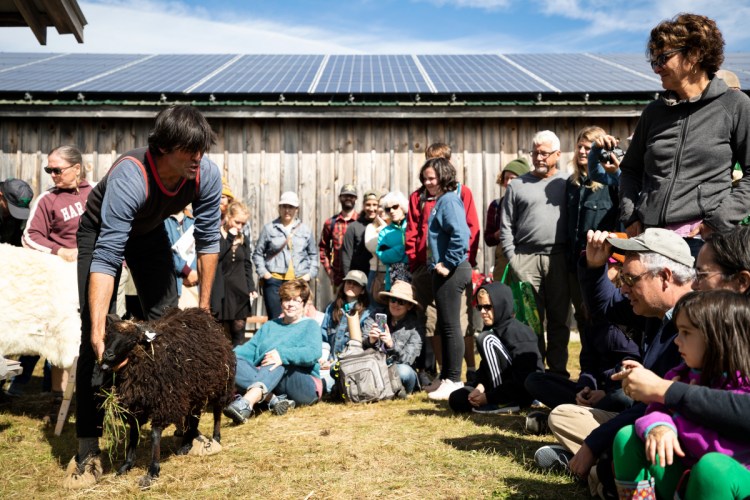UNITY — Jeff Burchstead led a shaggy chocolate-colored sheep into the center of a barn Saturday at the Common Ground Country Fair, maneuvering the animal effortlessly until she flopped down on her hind legs atop his feet, ready for a new haircut.
Then, with the same pattern in mind he’s used on thousands of sheep across Maine, Burchstead brought a razor to the sheep’s belly and began to shave away at its wool.
Next came the crotch, hind legs, rear end and the top of the sheep’s head. Then the neck, left side and right side.
“It’s like people going to the dentist,” Burchstead said, stopping to answer a question about how the sheep was feeling about the shearing demonstration. “Some people go to the dentist and they fall asleep. They love it. Others hate it. They run the gamut.”
After a total of about six minutes, a soft, dark fleece lay on the ground and the newly shaved sheep, her coat soft and short, slipped away.
By his own count, Burchstead is one of just about six or seven professional sheep shearers in the state of Maine.
He shears 2,500 to 3,000 sheep per year as well as some goats and alpacas. This weekend he showed off some of his skills at the fair. The three-day Common Ground Country Fair, now in its 42nd year, is known for its emphasis on organic living, sustainability and local agriculture.
This is the first time in about 10 years the fair has featured sheep shearing, a skill fewer and fewer people are learning how to do, Fair Director April Boucher said.
“It’s not a very lucrative thing to shear sheep, but it’s so vital to our communities,” Boucher said. “Sheep can be a really integral part of the agricultural landscape, so it’s an infrastructure that’s needed, just like processing animals or milling grains.”
Burchstead, 45, began shearing about 15 years ago at Darthia Farm in Gouldsboro and now runs his own farm, Buckwheat Blossom Farm, with his wife, Amy, in Wiscasset. He charges $7 per sheep, plus $3 to trim hooves and a travel fee that varies based on where he’s going — anywhere from York to Van Buren, in the upper reaches of Aroostook County.
The work is challenging and physical, but demand is good, Burchstead said as he put on his shearing uniform of felt moccasins, which slide easily under the sheep’s body during the shearing process and help stabilize the animal; tight pants to prevent the sheep from grabbing on to the cloth legs; and a tucked-in singlet to protect the back and rear end and allow for good arm mobility.
Most sheep get sheared once per year — in the spring — though some also get sheared in the fall, Burchstead said. He uses a mechanical blade, but many shearers still use traditional blades to shear their animals.

Jeff Burchstead holds a pair of manual shears Saturday morning during his sheep-shearing demonstration at the Common Ground Country Fair in Unity.
The traditional blades’ advantage is that they can leave more wool on the sheep, helping the animal to regulate its temperature better, depending on the time of year, though they are slower than the mechanical method.
On Saturday, as Burchstead led a Navajo-Churro sheep out of its pen, he explained to a crowd of about 50 people how he approaches each animal, starting with its belly, where the wool is often coarser and dirtier and ends up getting discarded.
Then, he’ll move to the crotch, hind legs, rear end and the top of its head.
Next comes the neck, left side and then the right side. By the end, he’s created a fluffy pile of wool, known as the fleece, that can be washed and processed into yarn.
He said the trick to keeping a sheep comfortable during the process is the positioning of the shearer’s body and having a good temperament.
“It really takes a lot of respect for sheep as an animal and what they can do for us, and respect for that fiber,” Burchstead said. “That’s the key to shearing. It’s hard to be a good shearer if you don’t have that. It’s just a really rewarding profession.”
Rachel Ohm — 612-2368
Twitter: @rachel_ohm
Send questions/comments to the editors.




